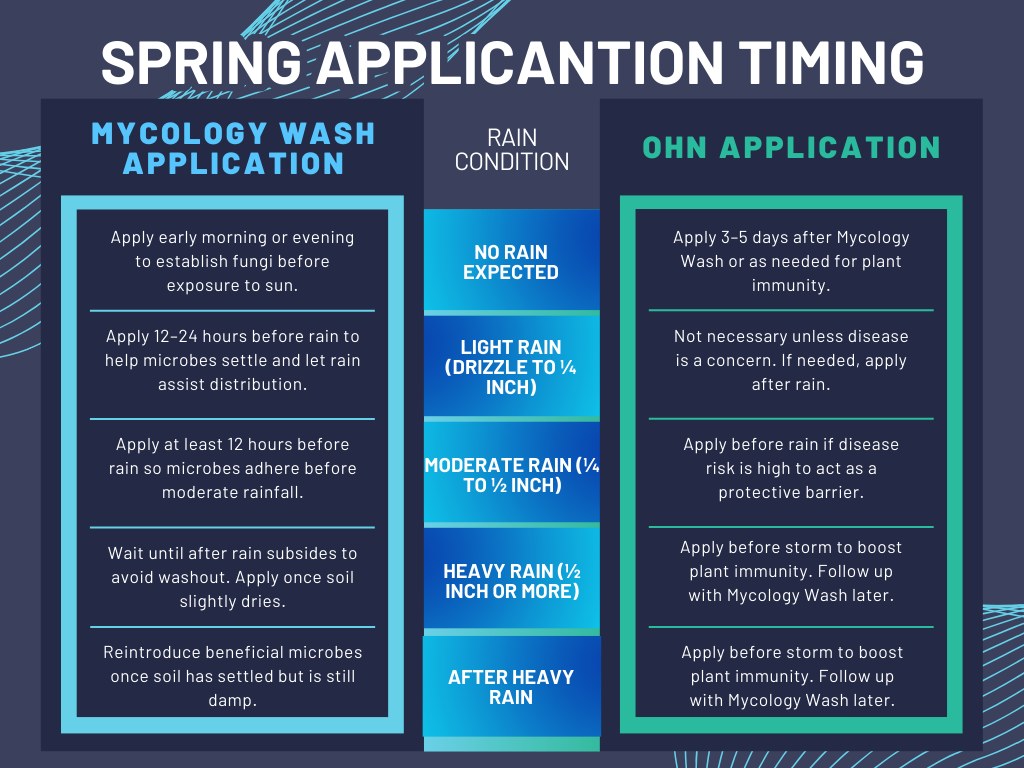Boosting Soil & Plant Health
Mycology Wash & OHN Application
Spring rains bring life back to the garden, but they also introduce challenges—nutrient runoff, soil imbalances, and the potential for disease. To set the season up for success, I use two powerhouse natural applications: a mycology wash to restore beneficial fungi and Oriental Herbal Nutrient (OHN) to strengthen plant immunity. When timed right, they work together to create a thriving, resilient garden ecosystem.
Step 1: Mycology Wash – Feeding the Soil
Fungi are the backbone of a healthy soil food web, helping plants access nutrients, retain moisture, and fend off disease. A mycology wash reintroduces beneficial fungi and bacteria to the soil, reinforcing microbial networks that may have been depleted over time.
Recipe for a Mycology Wash
This mix creates a fungal-rich solution to drench the soil and coat plant roots:
- Rainwater or dechlorinated water – 5 gallons
- Mushroom slurry or spent substrate – 1 to 2 cups
- Leaf mold tea – 2 cups (optional, but excellent for diverse microbes)
- Molasses – 1 tablespoon (to feed microbes)
- KNF Inputs (optional) – A small amount of Indigenous Microorganisms (IMO) or Fermented Plant Juice (FPJ) can supercharge the mix.
How to Apply
- Best Time: Apply in the early morning or evening when microbes can settle before exposure to harsh sunlight.
- Before Rain? If a light rain (¼ inch or less) is coming, apply 12–24 hours before to help microbes establish. If heavy rain is expected, wait until the soil slightly dries after the storm.
- Method: Drench garden beds, around plant roots, and even apply as a foliar mist for additional microbial benefits.
Step 2: OHN – Strengthening Plant Immunity
Once the microbial foundation is set, I turn to Oriental Herbal Nutrient (OHN), a KNF ferment that enhances plant immunity, making them more resistant to diseases and pests. It’s made from fermented garlic, ginger, cinnamon, licorice, and angelica root—herbs known for their antimicrobial and immune-boosting properties.
OHN Application Timing with a Mycology Wash
- If Disease Risk is High: Apply OHN before a mycology wash (3–5 days apart) to clear harmful pathogens, then reintroduce beneficial microbes.
- If Prioritizing Fungal Growth: Apply OHN after a mycology wash, waiting at least 3–5 days to avoid disrupting fungal colonization.
- Before Heavy Rain: OHN can act as a protective barrier against disease. Apply before the storm, then follow up with a mycology wash once conditions dry.
Dilution & Application
- Dilution Ratio: 1 part OHN to 500–1000 parts water (1:500–1:1000).
- Foliar Spray: Apply in the evening or early morning to coat leaves.
- Soil Drench: Pour around plant bases to strengthen root immunity.
- Seed Soak: Use a 1:1000 ratio and soak seeds for 15–30 minutes before planting.
Bringing It All Together: A Seasonal Approach
Early Spring (Before Planting):
- Start with a mycology wash to build soil biology.
- Apply OHN 3–5 days later to strengthen plant immunity.
During the Growing Season:
- Use a mycology wash every few weeks to maintain fungal networks.
- Apply OHN weekly or biweekly as a foliar spray for disease prevention.
Before & After Rain:
- OHN before heavy rain to prevent disease.
- Mycology wash after rain to replenish beneficial microbes.
By working with nature’s cycles instead of against them, these applications give the garden a head start on the season, ensuring strong, resilient plants that thrive in any conditions.
Time to mix up a batch and let the microbes do their work!
